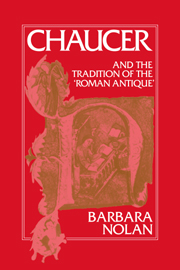Book contents
- Frontmatter
- Contents
- Acknowledgments
- List of abbreviations
- Introduction
- 1 Benoît de Sainte-Maure's Roman de Troie and the compositional practices of the roman antique
- 2 Plaits, debates, and judgments in the Roman de Thèbes, the Roman de Troie and the Roman d'Eneas
- 3 The poetics of fine amor in the French romans antiques
- 4 From history into fiction: Boccaccio's Filostrato and the question of foolish love
- 5 Boccaccio's Teseida and the triumph of Aristotelian virtue
- 6 Saving the poetry: authors, translators, texts, and readers in Chaucer's Book of Troilus and Criseyde
- 7 The consolation of Stoic virtue: Chaucer's Knight's Tale and the tradition of the roman antique
- Epilogue
- Notes
- Bibliography
- Index
1 - Benoît de Sainte-Maure's Roman de Troie and the compositional practices of the roman antique
Published online by Cambridge University Press: 11 September 2009
- Frontmatter
- Contents
- Acknowledgments
- List of abbreviations
- Introduction
- 1 Benoît de Sainte-Maure's Roman de Troie and the compositional practices of the roman antique
- 2 Plaits, debates, and judgments in the Roman de Thèbes, the Roman de Troie and the Roman d'Eneas
- 3 The poetics of fine amor in the French romans antiques
- 4 From history into fiction: Boccaccio's Filostrato and the question of foolish love
- 5 Boccaccio's Teseida and the triumph of Aristotelian virtue
- 6 Saving the poetry: authors, translators, texts, and readers in Chaucer's Book of Troilus and Criseyde
- 7 The consolation of Stoic virtue: Chaucer's Knight's Tale and the tradition of the roman antique
- Epilogue
- Notes
- Bibliography
- Index
Summary
Any discussion of the French romans antiques owes a great debt to previous scholars. From them we have learned to identify shared features in the Roman de Thèbes, the Roman de Troie, and the Roman d'Eneas. We expect to find classical historical matter translated from Latin into romanz, characters of high birth, an Ovidian love interest, and a delight in merveilles and mirabilia. We also anticipate a thematic interplay between amor and militia and a verse-form suited to discourse rather than chanting. In addition, we look for a concern with academic saveir or science. We know too that the authors of the twelfth-century romans antiques designed their poems (and their lessons on secular moral conduct) for small, aristocratic, listening audiences, and we expect that the audience's anticipated roles will be explicitly written into the text.
But to make such a list of characteristics does not fully explain either the poetics of the French romans antiques or their attraction for some of the Middle Ages' greatest writers. In this chapter I examine Benoît de Sainte-Maure's conception of his Roman de Troie as a livre, his self-dramatization as an auctor, and some of his most important compositional principles. Troie is a poem in which, as Edmond Faral observed long ago, the twelfth-century roman antique achieved its “plus grand épanouissement.”
- Type
- Chapter
- Information
- Chaucer and the Tradition of the Roman Antique , pp. 14 - 47Publisher: Cambridge University PressPrint publication year: 1992



